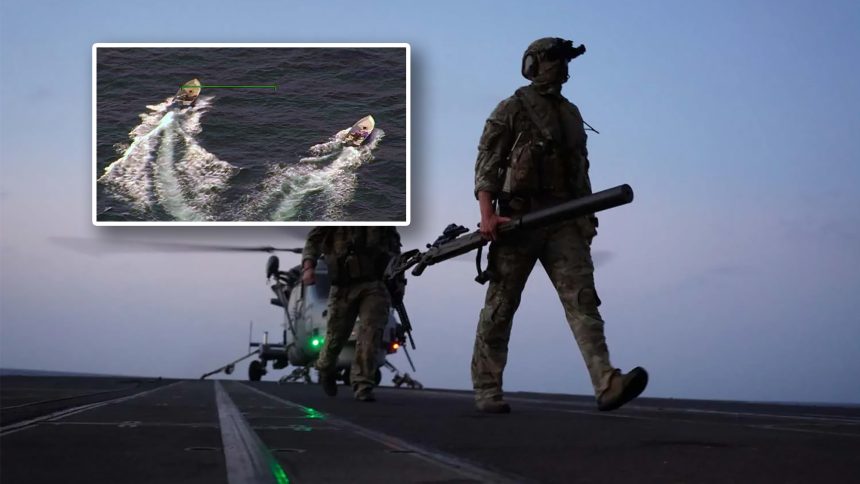Royal Marines took aim at the engine of a boat suspected of drug smuggling while flying in HMS Lancaster’s Wildcat helicopter over the Gulf of Oman. £35 million of drugs were subsequently seized.
Three skiffs were first identified by the Wildcat helicopter’s crew after launching on an early morning patrol from Type 23 frigate HMS Lancaster, which has been deployed to the Middle East with rotating crews since 2022. Lancaster subsequently deployed its other embarked air asset, a Peregrine rotary wing uncrewed aerial system (RWUAS), to continue tracking the skiffs undetected while the Wildcat returned to the ship for a top-up of fuel. While on deck, the helicopter picked up a Maritime Sniper Team from the ship’s embarked complement of Royal Marines from 42 Commando.
After returning to the scene, the Wildcat HMA2 closed in on the skiffs and made its presence known for the first time. Spooked, the skiffs’ operators increased their speed to over 40 knots and ditched parts of their cargo in an attempt to escape. Two of the three boats were abandoned as a result. The third was stopped by a single round from the sniper team, who opened fire on the outboard motor while the aircraft’s pilots flew backwards and provided as stable of a firing platform as possible.
Hoofin’ shootin’ 👏💪
Pinpoint accuracy from @RoyalMarines snipers of @42_commando in an @815NAS Wildcat from @HMSLANCASTER stopped traffickers in their tracks as their engine was disabled while trying to flee with £35m illegal drugs in the Gulf.
🔗https://t.co/Cx7mb3HFci pic.twitter.com/vAVMiSAS4I
— Royal Navy (@RoyalNavy) October 12, 2025
Drug smuggling in the Gulf region has traditionally relied upon slow moving ‘dhows’ rather than high speed craft like skiffs, which are more typical of Caribbean smuggling operations. While Wildcat helicopters have hosted Maritime Sniper Teams during previous busts, this was the first time they were called upon to open fire and disable a vessel. The slow moving nature of the usual dhows means initial intercepts can be made by the frigates’ own boats, with the snipers providing overwatch.
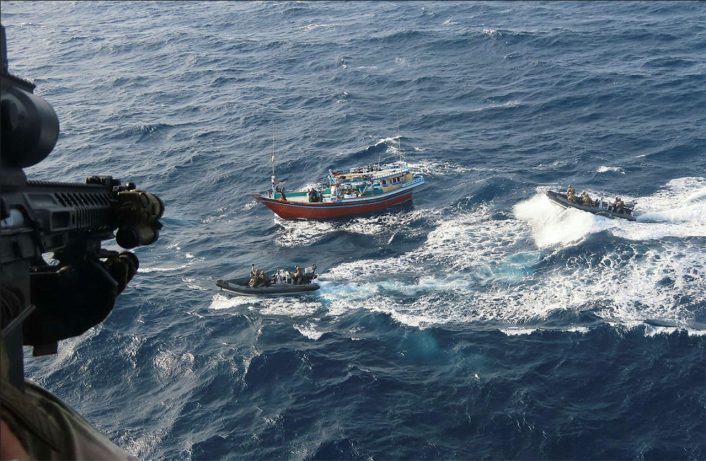
Boats were launched from Lancaster to investigate further, recovering over 1.5 tonnes of narcotics including heroin, crystal methamphetamine, and hashish. According to the UK Government, the total haul of seized goods would have a street value of £35 million.
Commanding Officer of HMS Lancaster, Commander Sam Stephens, said he is “hugely proud of the team’s professionalism, patience, and skill throughout what was a protracted chase,” adding that the operation “saw Lancaster’s crewed and uncrewed aircraft working hand-in-glove under the direction of the ship’s operations room. The outcome was a highly-successful bust, removing large quantities of narcotics from the streets and preventing their profits from fuelling extremism.”
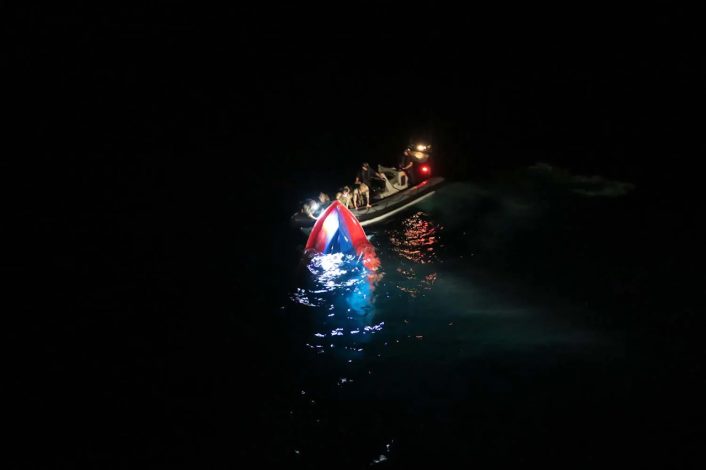
The Wildcat helicopter was piloted by Lieutenant Guy Warry of 815 Naval Air Squadron (NAS). He said that “being the Wildcat pilot carrying out a live weapons firing on drug-running skiffs whilst flying backwards to provide a stable platform for the snipers was definitely a career highlight.”
Member of Parliament and Minister for the Armed Forces Al Carns celebrated the news. “Not only have our Royal Navy and Royal Marines disrupted a major criminal enterprise and kept drugs off our streets and away from our kids, but have once again demonstrated effectiveness, decisive action and the exceptionally high standard of our Royal Navy and Marines. I salute our Royal Navy and Royal Marines for their indefatigable work keeping us safe at home and strong abroad.”
Operation Kipion
Royal Navy presence in the Gulf region to tackle smuggling and piracy operations, as well as play a wider part in regional security and conduct exercises with local allies, has been constant for many years under the codename Operation Kipion, though the level of deployed assets has varied. Prior to HMS Lancaster’s arrival in 2022, the long term forward deployed frigate was HMS Montrose. Before Montrose’s deployment, the use of frigates or destroyers was a more sporadic affair, with the permanent presence instead provided by a Royal Fleet Auxiliary Bay class amphibious auxiliary and a fleet of mine countermeasures vessels (MCMVs).
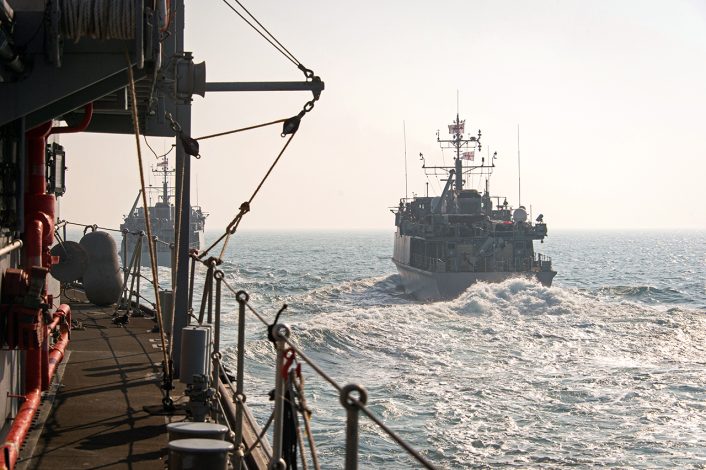
The deployed MCMV force used the Bay class as a ‘mothership’ until the larger vessel was withdrawn from the deployed presence due to a mix of RFA personnel shortages and Bay class availability. As MCMVs themselves have been gradually phased out of Royal Navy service in favour of emerging uncrewed systems, the deployed force of 9 Mine Countermeasures Squadron has also been reduced. Previously comprising four vessels, the squadron currently has two ships assigned, though one, HMS Bangor, is still out of service following a 2024 collision. The squadron operates from the United Kingdom Naval Support Facility in Bahrain, which is commissioned as HMS Jufair.
Kipion is likely to be HMS Lancaster’s final deployment, and the ship is expected to return to the UK to decommission later this year. The Royal Navy’s Type 23 frigates have remained in service longer and been worked harder much more than expected, due to downsizing of other parts of the Royal Navy fleet and delays to the Type 26 frigate program. From a force of 13 Type 23s notionally in service in 2020, the force, including Lancaster, now sits at 8 vessels.
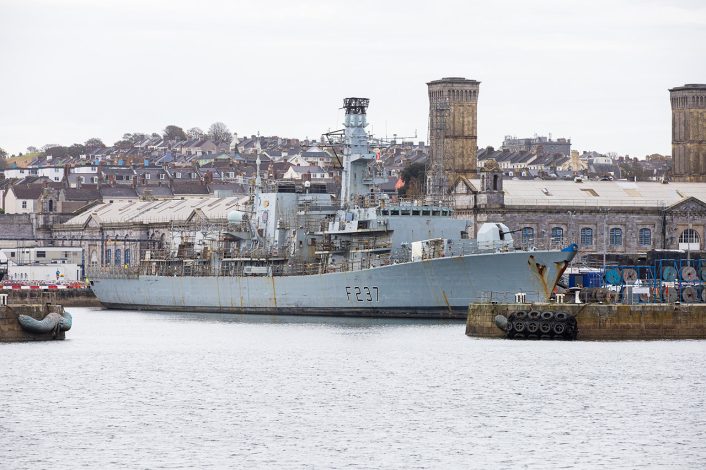
Ships intended to undergo refits to extend their service lives, like HMS Westminster, have subsequently been found to be beyond economic repair. While the Type 23s struggle on, the Royal Navy’s other escort force, its Type 45 destroyers, have faced low availability while the fleet undergoes major refits to upgrade propulsion systems which had been facing major reliability issues in warmer waters.
Due to the shortage of Type 23s, Lancaster’s withdrawal from Kipion will be without a direct replacement. Type 26 frigates are expected to begin entering Royal Navy service in 2028, though some later ships in the class may be delayed by the need to provide vessels for the Royal Norwegian Navy after a much-celebrated export order success. Mitigating the impact of this, though, is an increased level of co-operation between the already close Norwegian and British navies that will see both fleets of Type 26s working towards common goals in waters of Northern Europe.
Additionally, general-purpose Type 31 frigates are presently scheduled to enter service around the same time. These hulls, though cheaper and theoretically lower in capability compared to the high end Type 26s, are ideally suited for deployments like Kipion. This then allows the anti-submarine warfare specialist Type 26 hulls to focus on the important tasks of protecting the UK’s nuclear deterrent submarines as the Towed Array Patrol Ship (TAPS) or escorting the Queen Elizabeth class aircraft carriers. Type 31s will carry the same Sea Ceptor missile defence system already battle proven on board the Type 23, as well as a Mk 110 57mm main gun and two Bofors 40mm auxiliary guns.

